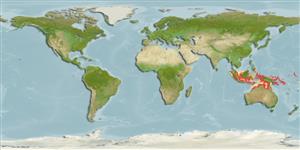>
Ovalentaria/misc (Various families in series Ovalentaria) >
Ambassidae (Asiatic glassfishes)
Etymology: Ambassis: Derived from Greek, anabasis = climbing up (Ref. 45335).
Eponymy: Rev George Harvey Vachell (1799–1839) was chaplain to the British East India Company’s factory at Macao. [...] (Ref. 128868), visit book page.
More on author: Richardson.
Environment: milieu / climate zone / depth range / distribution range
Ökologie
seewasser; süßwasser; brackwasser demersal; ozeanodrom (Ref. 51243). Tropical; 5°N - 17°S
Indo-West Pacific.
Size / Gewicht / Alter
Maturity: Lm ? range ? - ? cm
Max length : 6.5 cm SL Männchen/unbestimmt; (Ref. 44894)
Rückenflossenstacheln (insgesamt) : 8; Rückenflossenweichstrahlen (insgesamt) : 9; Afterflossenstacheln: 3; Afterflossenweichstrahlen: 9.
Found in brackish waters of bays, estuaries and tidal mangrove creeks, sometimes entering fresh water (Ref. 2847, 44894). Occurs in lotic and lentic freshwater (Ref. 7300).
Life cycle and mating behavior
Geschlechtsreife | Fortpflanzung | Ablaichen | Eier | Fecundity | Larven
Paxton, J.R., D.F. Hoese, G.R. Allen and J.E. Hanley, 1989. Pisces. Petromyzontidae to Carangidae. Zoological Catalogue of Australia, Vol. 7. Australian Government Publishing Service, Canberra, 665 p. (Ref. 7300)
IUCN Rote Liste Status (Ref. 130435: Version 2024-1)
Bedrohung für Menschen
Harmless
Nutzung durch Menschen
Tools
Zusatzinformationen
Download XML
Internet Quellen
Estimates based on models
Preferred temperature (Ref.
123201): 26.9 - 29.1, mean 28.4 °C (based on 526 cells).
Phylogenetic diversity index (Ref.
82804): PD
50 = 0.5000 [Uniqueness, from 0.5 = low to 2.0 = high].
Bayesian length-weight: a=0.01202 (0.00496 - 0.02912), b=3.02 (2.83 - 3.21), in cm total length, based on LWR estimates for this Genus-body shape (Ref.
93245).
Trophic level (Ref.
69278): 3.3 ±0.4 se; based on size and trophs of closest relatives
Generation time: 2.1 ( na - na) years. Estimated as median ln(3)/K based on 2
growth studies.
Widerstandsfähigkeit (Ref.
120179): hoch, Verdopplung der Population dauert weniger als 15 Monate. (K=0.55; Assuming Fec > 10,000).
Fishing Vulnerability (Ref.
59153): Low vulnerability (24 of 100).
